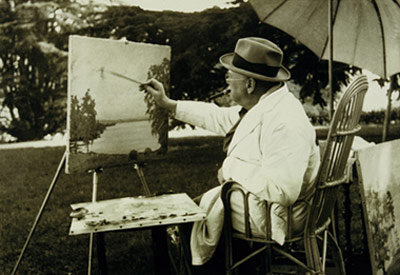In the Alps
dal 5/10/2006 al 1/1/2007
Segnalato da
Arnold Bocklin
Monica Bonvicini
Christoph Buchel
Balthasar Burkhard
Alexandre Calame
Valentin Carron
Peter Doig
Gustave Dore
Giovanni Giacometti
Jean-Luc Godard
Ferdinand Hodler
Eduard Imhof
Jacques-Henri Lartigue
Armin Linke
Walter Mittelholzer
Arnulf Rainer
Gerhard Richter
John Ruskin
Giovanni Segantini
Helmut Stallaerts
J.M.W. Turner
Eugene-Emanuel
Viollet-le-Duc
Caspar Wolf
Tobia Bezzola
Catherine Hug
Christoph Becker
Beat Gugger
5/10/2006
In the Alps
Kunsthaus Zurich, Zurich
The imagery of the Alpine world from the 17th century to the present day

Kunsthaus Zurich shows 'In the Alps', an exhibition devoted to the imagery of the Alpine world from the 17th century to the present day.
From 6 October 2006 until 2 January 2007 Kunsthaus Zurich shows how the
Alps have been seen by experts, artists and amateurs, and thus transformed
from a natural feature into a cultural phenomenon. The exhibition offers a
veritably kaleidoscopic view of the topic from the 17th century to the present
day. Its 300 items include votive tablets, cartographic models, early tourists'
snapshots and examples of both commercial and fine art, from the classics of
alpine landscape painting to the most recent work of contemporary artists.
The Alps are not only the source of Europe's great rivers: they have also given
rise to a flood of images that have fertilised European culture since the 18th
century. No other landscape has generated such an abundant wealth of imagery,
none has so radically formed and altered the artistic vision. The Zurcher
Kunstgesellschaft, which has been collecting landscapes for more than 200
years now, has cast a wide net in its approach to this exhibition.
The history of the perception and representation of the Alps goes far beyond the
usual cliche' 'from the terrible to the sublime'. The way the mountains are
viewed, after all, is primarily a function of the general expansion of the visible
world, and the appreciation of the Alpine landscape's aesthetic appeal has
flowed from its conquest and subjection to the technical mastery of human
civilisation.
Conquered by science, technology and tourim
Although our image of the Alps has been shaped by artists, their representations
would be impossible without the work of cartographers and geologists, military
engineers, bridge and tunnel builders and visionaries of the tourism industry, all
of whom have trained their detached gaze upon the Alpine terrain.
Spiritual experience, political and religious symbol
From earliest times the Alps have afforded an experience of the spiritual
dimension; today, as well as being a challenge for the athletically minded, they
continue to serve as a political and religious symbol. In addition to imposing a
rational, pragmatic lifestyle on those who dwell there, the harsh conditions of
subsistence among the Alpine peaks and valleys have always exercised a
fascination upon the artistic imagination far beyond that of a pretty subject for a
landscape. As for the visual vocabulary of those who have set out to dominate
the highlands by means of scientific theory and civilising practice, it turns up in
our everyday life in the form of hiking maps and atlases. The rich tradition of
commercial and popular images of the Alps is preserved in local history museums and, as souvenirs, makes its way across the world. The political
representations of freedom and independence, produced particularly in
Switzerland, as well as the individual visions of artists and outsiders have held
entire cultures in their thrall.
Exhibition in 4 chapter
Tobia Bezzola, the exhibition's curator, has divided the panorama into four
chapters: the practical exploitation of the Alps; their discovery by science; their
religious, mythical and spiritual dimensions; and their value as a site of leisure
activities such as travel, sport and spa tourism.
It contains the work of distinguished amateurs like Winston Churchill as well as
great masterpieces of Alpine painting, whether by the romanticist J.M.W. Turner
or by Alexander Calame, by the symbolist Giovanni Segantini or by Ferdinand
Hodler, and also includes contemporary photographs by Nicolas Faure
documenting the ruinous effect of climate change on geological formations as
well as on Alpine flora and fauna.
Taken together, the works presented highlight the links between rationalism
and spirituality in a cultural sphere that has been removed from the quotidian
world of natural contingency only to be aesthetically abstracted and subjected to
an ongoing process of democratisation and mass-marketing in the name of the
tourism industry.
Artist
Arnold Bocklin, Monica Bonvicini, Christoph Buchel, Balthasar Burkhard,
Alexandre Calame, Valentin Carron, Peter Doig, Gustave Dore', Giovanni
Giacometti, Jean-Luc Godard, Ferdinand Hodler, Eduard Imhof, Jacques-Henri
Lartigue, Armin Linke, Walter Mittelholzer, Arnulf Rainer, Gerhard Richter, John
Ruskin, Giovanni Segantini, Helmut Stallaerts, J.M.W. Turner, Euge'ne-Emanuel
Viollet-le-Duc, Caspar Wolf and many others.
Catalogue
The catalogue (in German language only) accompanying 'In the Alps' features
the 138 creators of the Alpine imaginary in alphabetical order and is designed to
serve as a practical guide for visitors to the some 300 items that make up the
exhibition. It contains 272 pages, featuring 181 monochrome images and texts by
Tobia Bezzola, Catherine Hug, Christoph Becker, Beat Gugger and others. It is
on sale at the Kunsthaus Shop for CHF 39.-.
With support from the Vontobel Foundation and the Hans Imholz Foundation.
Image: J. Luscher, Churchill Painting, 1946, Black-and-white photograph 33.5 x 40.8 cm (c) Schweizerisches Landesmuseum, Zurich
Kunsthaus Zurich
Heimplatz 1 - Zurich
Open Tues-Thurs 10 a.m.-9 p.m., Fri-Sun 10 a.m.-5 p.m., closed on Mondays. Public Holidays 24, 26, 31 December, 1 and 2 January 10 a.m.-5 p.m.
Public Guided Tours: Tuesdays 12.15 p.m., Wednesdays 6.30 p.m., Fridays 3 p.m.,
Sundays 11 a.m.
Private guided tours can be arranged by phoning +41 (0)44 253 84 84 (Mon-Fri 9
a.m.-12 noon).
Admission CHF 16.- / 10.- (concessions) / 12.- per head for groups of 20 or more.



